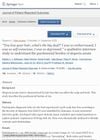Search
for
Sort by
Research
240-270 / 295 results
research Inhibition of Wnt/β-Catenin Pathway Promotes Regenerative Repair of Cutaneous and Cartilage Injury
Blocking the Wnt/β‐catenin pathway can speed up wound healing, reduce scarring, and improve cartilage repair.
research Genetic Basis of Alopecia Areata
More research is needed to understand the genetic causes of Alopecia areata to develop better treatments.
research The Role of Serum Th1, Th2, and Th17 Cytokines in Patients with Alopecia Areata: Clinical Implications
Alopecia areata severity and treatment response are linked to specific cytokine levels.
research Screening Guidelines for Thyroid Function in Children With Alopecia Areata
Children with alopecia areata should only have thyroid screening if they have Down syndrome, a history of atopy, family history of thyroid disease, or signs of thyroid problems.

research ‘You Lose Your Hair, What’s the Big Deal?’ I Was So Embarrassed, I Was So Self-Conscious, I Was So Depressed: A Qualitative Interview Study to Understand the Psychosocial Burden of Alopecia Areata
Alopecia Areata (AA) causes significant emotional distress, including feelings of embarrassment, depression, and anxiety, and impacts social interactions and daily activities.

research Tofacitinib (Selective Janus Kinase Inhibitor 1 and 3): A Promising Therapy for the Treatment of Alopecia Areata: A Case Report of Six Patients
Tofacitinib helped regrow hair in patients with alopecia, with few side effects.
research Complete Regrowth of Beard Hair with Ruxolitinib in an Alopecia Universalis Patient
Ruxolitinib helped a man regrow his beard after years of hair loss.
research Serum Vitamin D Levels and Alopecia Areata: A Hospital-Based Case-Control Study from North India
People with Alopecia areata often have lower Vitamin D levels, which might affect the severity of their condition.

research Commonalities Between COVID-19 and Radiation Injury
Some drugs may help treat both COVID-19 and radiation injury.
research Exomic Sequencing of Immune-Related Genes Reveals Novel Candidate Variants Associated with Alopecia Universalis
HLA-DRB5 and other genes may be linked to alopecia universalis.
research Medium-Dose Prednisolone Pulse Therapy in Alopecia Areata
Medium-dose prednisolone pulse therapy is effective and safe for multifocal alopecia areata but not for more severe forms.
research Alopecia Universalis During Treatment with Leflunomide and Adalimumab: Case Report
A patient lost all their hair while on rheumatoid arthritis medication.
research Transgenic Kallikrein 14 Mice Display Major Hair Shaft Defects Associated with Desmoglein 3 and 4 Degradation, Abnormal Epidermal Differentiation, and IL-36 Signature
Mice with extra human KLK14 had hair and skin problems, including weaker cell bonds and inflammation, linked to Netherton syndrome.

research A Hair-Raising History of Alopecia Areata
The document concludes that understanding and treatments for alopecia areata have significantly advanced, now recognizing it as an autoimmune disorder.
research Cancer Risk in Patients with Alopecia Areata: A Nationwide Population-Based Matched Cohort Study
Alopecia areata patients have varied cancer risks, with some cancers being lower and others higher.
research Prevalence and Risk Factors Associated with the Occurrence of Autoimmune Diseases in Patients with Alopecia Areata
Alopecia areata patients, especially women with nail issues or atopic diseases, are at higher risk for other autoimmune diseases.
research Comparison of High-Dose Corticosteroid Pulse Therapy and Combination Therapy Using Oral Cyclosporine with Low-Dose Corticosteroid in Severe Alopecia Areata
Corticosteroid pulse therapy is more effective for severe alopecia areata than combination therapy.
research Simvastatin/Ezetimibe Therapy for Recalcitrant Alopecia Areata: An Open Prospective Study of 14 Patients
Simvastatin/ezetimibe may help some patients with severe alopecia areata regrow hair.

research Hair Follicle-Derived Mesenchymal Stem Cells Decrease Alopecia Areata Mouse Hair Loss and Reduce Inflammation Around the Hair Follicle
Hair follicle stem cells reduced hair loss and inflammation in mice with a condition similar to human alopecia.

research Efficacy and Safety of Tofacitinib Therapy in Asian Patients with Severe Alopecia Areata
Tofacitinib helps regrow hair in severe alopecia patients, but more research is needed.

research A Systematic Simulation-Based Meta-Analytical Framework for Prediction of Physiological Biomarkers in Alopecia
The study identified 12 potential biomarkers for hair loss and how they affect hair growth.
research Diphencyprone Induced Vitiligo: A Case Report
Diphencyprone can cause unexpected and possibly permanent vitiligo.

research Chitosan Hydrogel as Tissue Engineering Scaffolds for Vascular Regeneration Applications
Chitosan hydrogels are promising for repairing blood vessels but need improvements in strength and compatibility.

research Network-Based Approaches Reveal Potential Therapeutic Targets for Host-Directed Antileishmanial Therapy Driving Drug Repurposing
Researchers identified five new potential targets for leishmaniasis treatment, suggesting repurposing existing drugs could be effective.
research Evaluation of Serum Levels of IL-6, IL-10, and TNF-a in Alopecia Areata Patients: A Systematic Review and Meta-Analysis
Alopecia areata patients have higher levels of IL-6 and TNF-α.
research A Retrospective Comparative Study of Two Concentrations of Intralesional Triamcinolone Acetonide in the Treatment of Patchy Alopecia Areata on the Scalp
Both concentrations of triamcinolone acetonide are effective for hair regrowth in patchy alopecia areata, but 5 mg/mL is recommended to reduce side effects.
research A Porcine Model for the Development and Testing of Preoperative Skin Preparations
Povidone iodine reduced skin bacteria more than chlorhexidine gluconate, but neither met FDA reduction standards.

research Thyroid Disease in Alopecia Areata, Lichen Planopilaris, and Frontal Fibrosing Alopecia: A Case Control Study of 144 Patients
Alopecia is not a significant predictor of thyroid disease when age and sex are considered.

research Exploring the Versatility of Microemulsions in Cutaneous Drug Delivery: Opportunities and Challenges
Microemulsions could improve skin drug delivery but face challenges like complex creation and potential toxicity.